JAPANESE-HELD OKINAWA UNDER U.S. ASSAULT
Aboard Admiral Spruance’s Flagship USS Indianapolis · April 1, 1945
For weeks the largest Allied fleet since D‑Day—nearly 1,500 U.S. and British vessels—fired 2.3 million shells onto Okinawa, the largest island in the Ryukyu archipelago and a little more than 300 miles/483 km from Kyūshū and Shikoku, the southernmost Japanese Home Islands. Kyūshū and Shikoku were home to many Japanese suicide squadrons, whose aviators found the Allied warships within easy reach.
Between March 27 and May 11, 1945, some 2,000 sorties by Marianas-based B‑29 Superfortresses cratered airfields on the two islands, particularly runways, as well as hammered hangars and workshops in an effort to suppress Japanese suicide aircraft; yet still a blizzard of bomb-laden death divers was able to sink or damage over 400 Allied ships during the Okinawa campaign. Many of the crippled ships never returned to action.
On this date in 1945, a cloudless Easter Sunday, 60,000 U.S. soldiers and Marines landed on Okinawa, launching Operation Iceberg. Overhead, ferocious attacks by these one-way airmen, or kamikaze, took a heavy toll in lives and damaged dozens of U.S. and British vessels that stood off the island. The kamikaze had been named after the divine wind that had, in medieval times, saved Japan from invasion. However at Okinawa kamikaze aviators loosed a new tactic against Allied ships offshore: not single kamikaze salvos but typhoons of hundreds of aircraft, including the newly developed Ohka manned missiles, descended on the fleet. Between April 1 and May 25, seven major kamikaze attacks were attempted, involving more than 1,500 planes flying from Kyūshū, Shikoku, and Formosa. The Japanese called these one-way squadrons “Floating Chrysanthemums,” and nearly all the pilots were half-trained adolescents, some as young as seventeen. Many had never flown solo or landed an airplane.
In spite of Japan’s suicide offensive, which also included land-based motorboats, by the middle of April American forces had secured three-quarters of the Long Island-sized island with relative ease. By then much harder fighting had started on the so-called Shuri Line to the south. It took two and a half more months of grueling close-quarter fighting before Japanese resistance ceased. When it did, the largest land battle of the Pacific War had claimed nearly 40,000 American casualties, with over 100,000 dead on the Japanese side, including over 1,000 one‑way pilots.
![]()
The 82-Day-Long Battle of Okinawa, or Operation Iceberg, April 1 to June 22, 1945
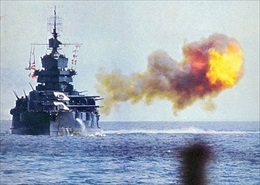 | 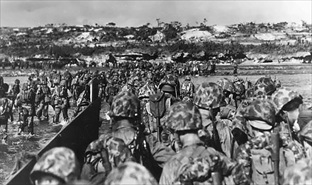 |
Left: The battleship USS Idaho shells Okinawa on April 1, 1945. The Idaho was one of seven U.S. battleships in Fast Carrier Force (TF 58) under Vice Admiral Marc Mitscher. British Carrier Force (TF 57) added two battleships to the 88 ships in TF 58, making a total of over 110 Allied warships off the coast of the Japanese-held island.
![]()
Right: Marines in camouflage battle dress storm out of a landing craft to establish a beachhead on Okinawa in the opening phase of Operation Iceberg. Two Marine divisions (the 1st and 6th) of 88,000 men and four divisions of the U.S. 10th Army (the 7th, 27th, 77th, and 96th) brought the number of U.S. combatants in the initial assault force close to 183,000 to face roughly 80,000 mixed army and navy Japanese and 40,000 Okinawan conscript defenders. Additionally, there were 18,000 Navy personnel (mostly Seabees and medical personnel) in support of Operation Iceberg.
 | 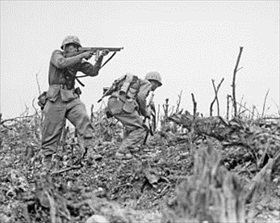 |
Left: U.S. Marines pass a dead Japanese soldier in a destroyed Okinawan village, April 1945. More than 110,000 defenders were killed in the 82-day campaign to take the island, and between 40,000 and 150,000 civilians (out of a population of 300,000) died by suicide or were killed during the protracted fighting. Allied casualties were over 65,000, of which more than 14,000 were killed or went missing in action.
![]()
Right: A U.S. Marine provides covering fire with his M1 Thompson submachine gun while another Marine with a Browning Automatic Rifle prepares to break cover to move to a different position. Northern Okinawa, May 1945.
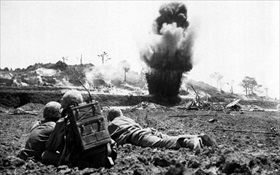 | 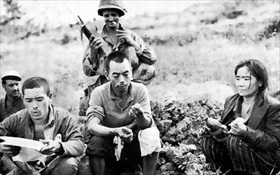 |
Left: A demolition crew from the 6th Marine Division watches dynamite charges explode and destroy a Japanese cave. Okinawa, May 1945.
![]()
Right: Overcoming the last resistance on Okinawa was aided by Allied propaganda leaflets, one of which is being read by a prisoner (about 7,000 enemy were taken alive) who awaits transportation to the rear. Many civilians gave up at the same time.
Okinawa: Last Great Land, Naval, and Air Battle of the Pacific Campaign
![]()

 History buffs, there is good news! The Daily Chronicles of World War II is now available as an ebook for $4.99 on Amazon.com. Containing a year’s worth of dated entries from this website, the ebook brings the story of this tumultuous era to life in a compelling, authoritative, and succinct manner. Featuring inventive navigation aids, the ebook enables readers to instantly move forward or backward by month and date to different dated entries. Simple and elegant! Click
History buffs, there is good news! The Daily Chronicles of World War II is now available as an ebook for $4.99 on Amazon.com. Containing a year’s worth of dated entries from this website, the ebook brings the story of this tumultuous era to life in a compelling, authoritative, and succinct manner. Featuring inventive navigation aids, the ebook enables readers to instantly move forward or backward by month and date to different dated entries. Simple and elegant! Click 











